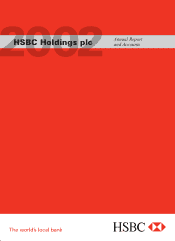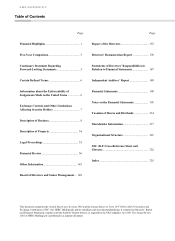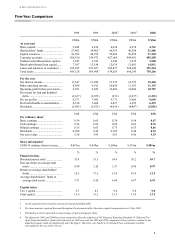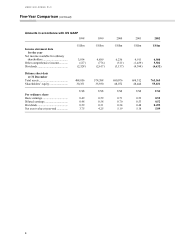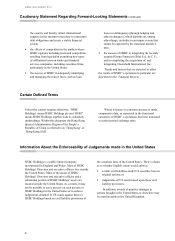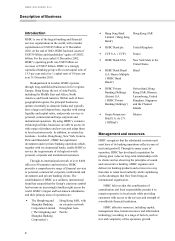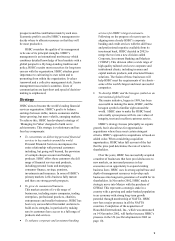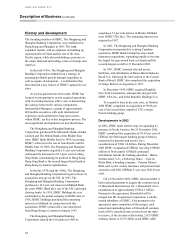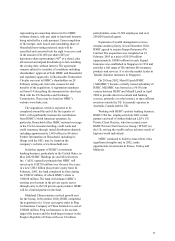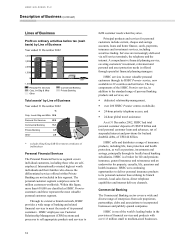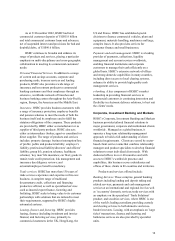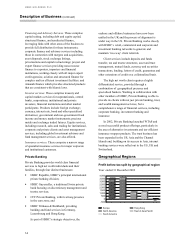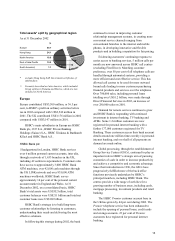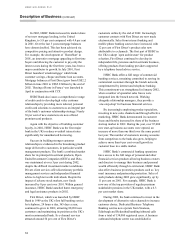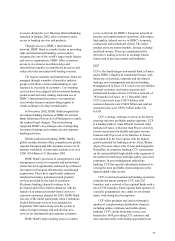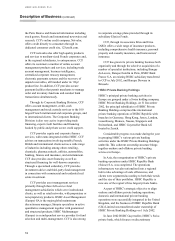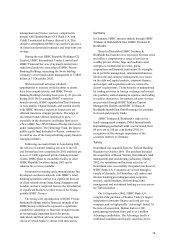HSBC 2002 Annual Report Download - page 11
Download and view the complete annual report
Please find page 11 of the 2002 HSBC annual report below. You can navigate through the pages in the report by either clicking on the pages listed below, or by using the keyword search tool below to find specific information within the annual report.
9
prospects and the contribution made by each area.
Economic profit is used by HSBC’s management to
decide where to allocate resources so that they will
be most productive.
HSBC considers the quality of its management
to be one of its principal strengths. HSBC’s
management is an international meritocracy which
combines detailed knowledge of local markets with a
global perspective. By long-standing tradition and
policy, HSBC recruits most executives for long-term
careers with the organisation. HSBC attaches great
importance to cultivating its own talent and to
promoting from within the organisation. It values
teamwork and a collective management style. Senior
management succession is seamless. Lines of
communication are kept short and speed of decision-
making is emphasised.
Strategy
HSBC aims to become the world’s leading financial
services organisation. HSBC’s goal is to balance
earnings between stable, mature economies and the
faster-growing, but more volatile, emerging markets.
To achieve this, HSBC has developed a strategy of
‘Managing for Value’ designed to build on its
achievements. This strategy is evolutionary and has
four key components:
• To concentrate on delivering personal financial
services to key markets around the world.
Personal Financial Services encompasses the
entire relationship with personal customers
including, but going well beyond, the provision
of a simple cheque account and lending
products. HSBC offers these customers the full
range of financial services and products,
including personal loans and mortgages,
consumer finance, savings, pensions,
investments and insurance. In none of HSBC’ s
primary markets is this business fully mature
and there are strong growth prospects.
• To grow its commercial business.
This market consists of a wide range of
businesses, including major companies, trading
enterprises, professional practices, charities,
entrepreneurs and smaller businesses. HSBC has
been very successful in this market and aims to
build on its strengths, in particular by making
sure its customers have access to a full range of
products and services.
• To enhance corporate and investment banking
services for HSBC’s largest customers.
Following on the progress of recent years in
aligning more closely HSBC’s corporate
banking and credit services with the skill base
and professional expertise available from its
investment bank, HSBC decided in 2002 to
merge the two into a new division called
Corporate, Investment Banking and Markets
(‘CIBM’ ). This division offers a wide range of
high quality tailored services to corporate and
institutional clients, including treasury and
capital markets products, and structured finance
solutions. The fusion of these businesses will
help HSBC meet the requirements of its clients –
some of the world’s largest and most successful
companies.
• To develop HSBC and the hexagon symbol as an
international global brand.
This major initiative, begun in 1998, has been
successful in making the name, HSBC, and the
hexagon symbol a familiar sight around the
world. HSBC aims to make the HSBC brand
universally synonymous with its core values of
integrity, trust and excellent customer service.
HSBC’s strategy focuses principally on organic
growth, but it also allows for opportunistic
acquisitions where these meet certain stringent
criteria. HSBC’s approach to acquisitions is based on
added value. When considering acquisition
opportunities, HSBC takes full account of the fact
that the price paid determines the rate of return to
shareholders.
Over the years, HSBC has successfully acquired
a number of businesses that have provided access to
new markets, an increased presence in key
economies or an opportunity to expand existing
business lines. HSBC uses its strong capital base and
depth of management resources to develop such
businesses into long-term generators of wealth for its
shareholders. In November 2002, HSBC made a
strategic move into Mexico with the purchase of
GFBital. This represents a strategic stake in a
country with a growing and under-banked population
in an economy with strong long-term growth
potential through membership of NAFTA. HSBC
now has a major presence in all the NAFTA
countries. Completion of the acquisition of
Household International, Inc., which was announced
on 14 November 2002, will further increase HSBC’ s
presence in the US (see Developments in 2002 on
page 10).

